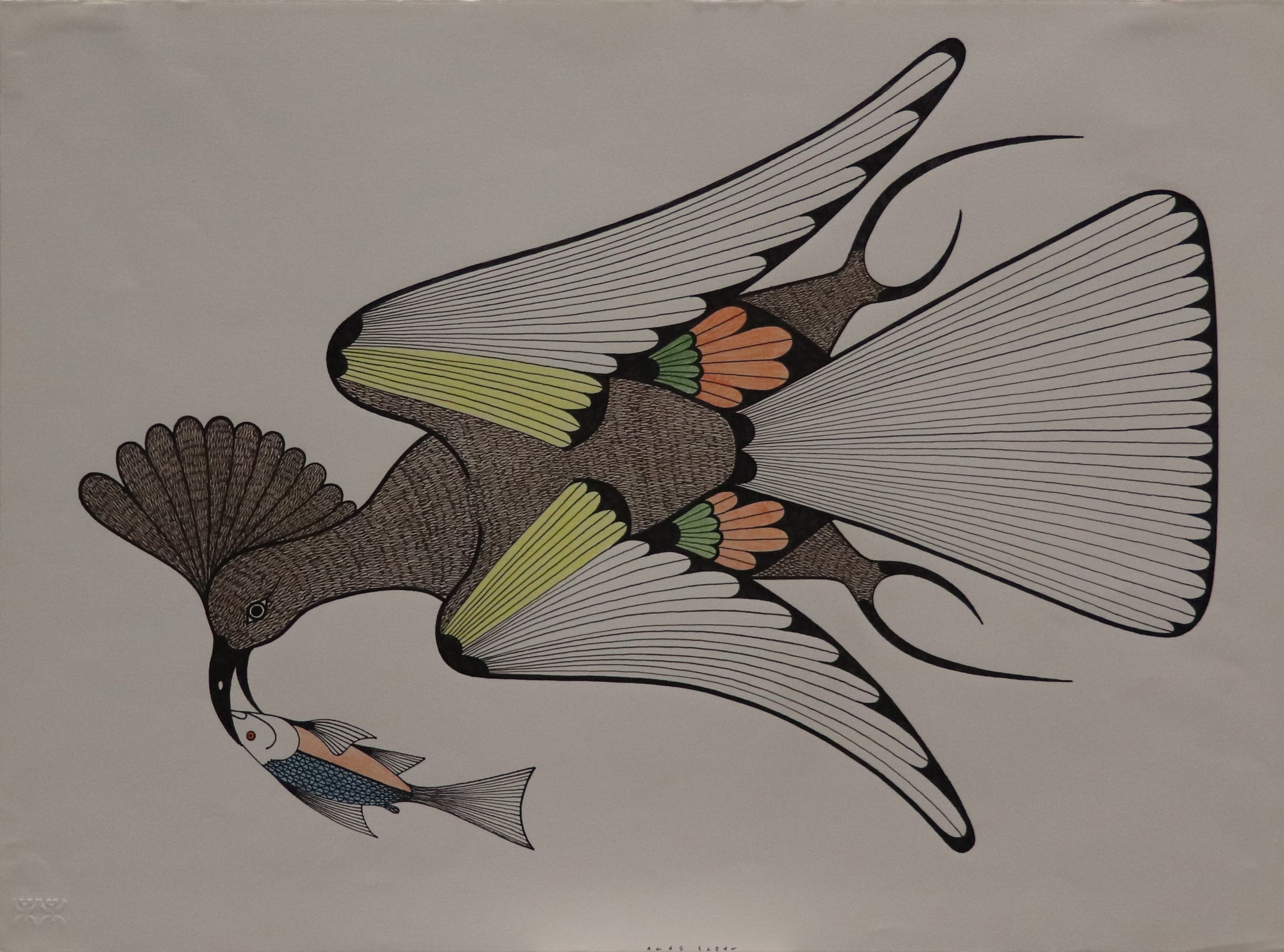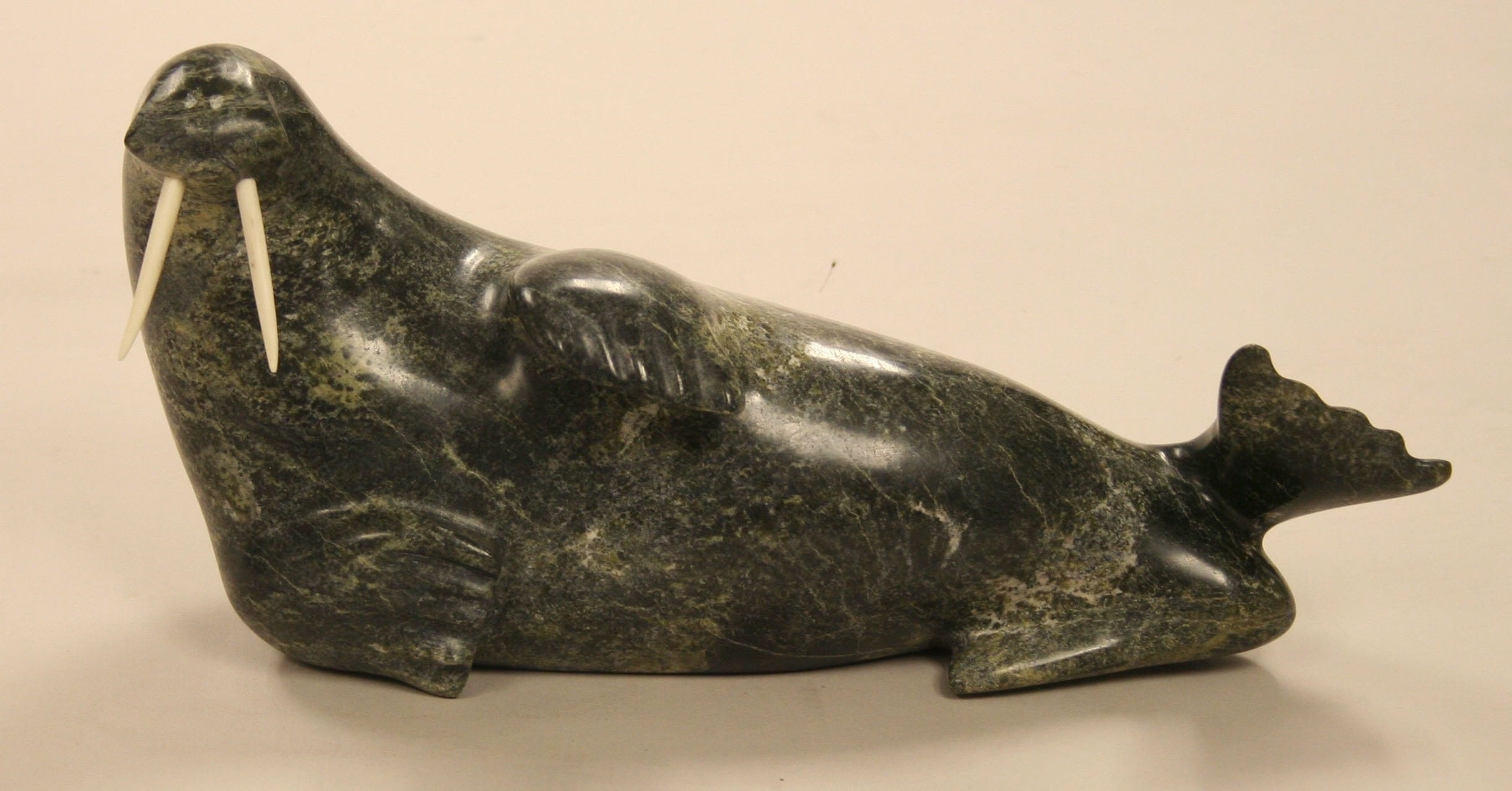Reciprocity.
The hybrid forms visible throughout the exhibition indicate exchanges between human, animal, and spirit realms. Several artists in this section depict powerful individuals who change form and communicate with other species in order to maintain the well-being of all. This is striking, given that Inuit and Yup’ik religious practices were interrupted by Christian missionaries in the Arctic beginning in the nineteenth century. Artistic representations of transformational figures and stories provide an invaluable platform for perpetuating the value of reciprocity through a history of colonization.
Bird and Fish
Eliyakota Samualie (Inuk, 1938 – 1987)
Ink and color pencil on paper
Museums Collections, Gift of Frederick & Lucy S Herman
Reproduced with the permission of Dorset Fine Arts
Walrus
Aoudla Pudlat (Inuk, 1951 – 2006)
Ink wash on paper
Museums Collections, Gift of Frederick & Lucy S Herman
Reproduced with the permission of Dorset Fine Arts
The aiviq, or walrus, is one of the most important food sources for Inuit. According to Inuit ethics, an animal will allow itself to be killed as long as the hunter behaves respectfully towards the animal. Respectful hunting practices include Surattittailimaniq (hunting only what is necessary and avoiding waste), Iliijaaqaqtailiniq (harvesting animals without malice), and Sirliqsaaqtittittailiniq (avoiding unnecessary harm). It is also important that the hunter shares his kill with his hunting partners, his family, and his community. The aiviq flipper, in particular, is associated with principles of meat-sharing for Inuit. According to custom, the hunter who killed the aiviq should cut off the right-front flipper and ceremonially offer it to his wife. Other hunters acknowledged as meat-sharing partners would receive the remaining flippers. Pudlat, whose oeuvre mainly consists of birds, emphasizes the enlarged and stylized flippers of the aiviq in this abstract drawing. While the flippers may appear wing-like due to the artist’s familiarity with avian forms, it is also likely that their significance to Inuit hunting ethics earned them special attention.
Sednas Braiding Hair
Mary Pudlat (Inuk, 1923 – 2001)
Ink and crayon on paper
Museums Collections, Gift of Frederick & Lucy S Herman
Reproduced with the permission of Dorset Fine Arts
According to Inuit oral histories, Sedna is an extraordinary being who inspires fear and awe through her control of the hunt. Following a series of misfortunes involving deception and betrayal, Sedna finds herself fundamentally transformed. Not only does she become part fish, but she also loses her fingers, which turn into sea animals. As a result, she relies on a shaman’s intervention to tame her hair when it flies loose during moments of rage.
In Mary Pudlat’s playful re-imagining of the story, Sedna has been both healed and doubled. Featuring hands that are whole and unmarred, each being is empowered anew for the task of personal maintenance. The Sedna on the right expertly braids the hair of her companion, who assists by holding it taut and steady. Pudlat has even included pearls around the neck of the Sedna on the left, an unusual and lighthearted gesture.
A Highlight Essay by Ramey Mize
Fish Man and Fish Woman
Germaine Arnaktauyok (Inuk, b. 1946)
Pen and ink on paper
Museums Collections, Gift of Frederick & Lucy S Herman
This drawing visualizes a story of sustenance and transformation. Arnaktauyok recounted, “There was an old couple who were starving. They were trying to fish, but the fish were ignoring their bait and there was nothing they could do. That’s when they said ‘Let’s become fish.’ So they jumped into the water and became fish.” The artist condensed the events into a single image and employed a fine-tipped pen in order to render exquisite details, down to each discrete scale.
Throughout her nearly fifty-year career, Arnaktauyok has engaged art making to reflect Inuit living history, cultural knowledge, and values. This particular image embodies Inuit notions of human-animal kinship and ecological interconnectedness.
Walrus
Mikisiti Saila (Inuk, 1939 – 2008)
Soapstone
Museums Collections, Gift of Carol A. Heppenstall
Reproduced with the permission of Dorset Fine Arts
Three Shamans
Pudlo Pudlat (Inuk, 1916 – 1992)
Graphite and marker on paper
Museums Collections, Gift of Frederick & Lucy S Herman
Reproduced with the permission of Dorset Fine Arts
The angakoq (spiritual leader) fulfills essential obligations for Inuit communities, including monitoring the weather, securing ample food supply, healing the sick, and maintaining societal and ecological balance. Both women and men can exhibit spiritual power through their abilities to shapeshift, fly, endure severe pain, invoke helping spirits, and see with x-ray vision. The generic English term “shaman” does not convey the complexity of this role. Pudlat’s drawing depicts a transitional stage in the metamorphosis of the angakoq.
Inuguaq (Doll)
Josephine Wassillie (Yup’ik, 1927 – 2012)
Fur, polychrome glass beads, leather, yuuyuuk (pom-poms)
Museums Collections, Gift of Mabel & Harley McKeague
A Highlight Essay by Elizabeth Humphrey
Inuit Riding a Goose
Mary Pudlat (Inuk, 1923 – 2001)
Ink and crayon on paper
Museums Collections, Gift of Frederick & Lucy S Herman
Reproduced with the permission of Dorset Fine Arts








